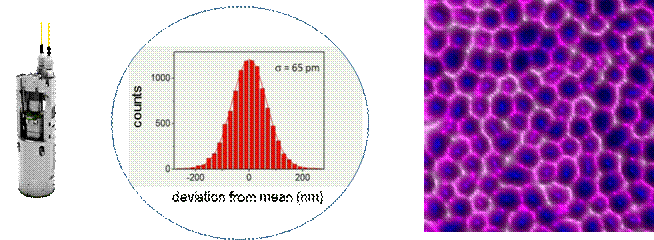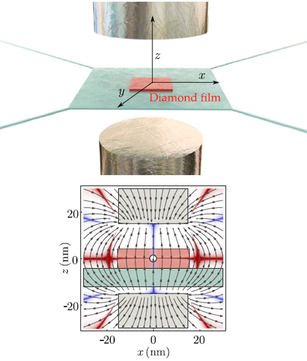|
Context of project
Liquid helium systems are the most used cryostats. However, the so-call wet systems are facing a critical period as a result of increasing cost and storage issues of liquid helium. Consequently, in many research labs and tech companies there are a rapidly growing demand for close cycle systems (so-called dry Cryo-systems). When it comes to applications such as SPM (Scanning Probe Microscopy), so far the residual vibrations created by the cryo-cooling mechanism in close cycle cryostats are a limiting factor. In this project we aim at reducing the spurious vibrations that limit cutting edge SPM characterization. Our work We report on state-of-the-art scanning probe microscopy measurements performed in a pulse tube based top- loading closed-cycle cryostat with a base temperature of 4K and a 9T magnet. We introduced measures to reduce the level of mechanical and acoustic noise coupling into the system to enable scanning probe experiments. The extremely low vibration amplitudes in our system enabled successful imaging of 0.39nm lattice steps on single crystalline SrTiO3 as well as magnetic vortices in Bi2Sr2CaCu2O8+x superconductor. Fine control over sample temperature and applied magnetic field further enabled us to probe the helimagnetic and the elusive skyrmion-lattice phases in Fe0:5Co0:5Si with unprecedented signal-to-noise ratio of 20:1. Finally, we demonstrate for the first time quartz-crystal tuning fork shear-force microscopy in a closed-cycle cryostat. Read more: Scanning probe microscopy in an ultra-low vibration closed-cycle cryostat: Skyrmion lattice detection and tuning fork implementation F.P. Quacquarelli, J. Puebla, T. Scheler, D. Andres, C. Bödefeld, B. Sipos, C. Dal Savio, A. Bauer, C. Pfleiderer, A. Erb, K. Karrai Microscopy Today 23 (6), 12-17 (2015) www.cambridge.org/core/journals/microscopy-today/article/scanning-probe-microscopy-in-an-ultralow-vibration-closedcycle-cryostat-skyrmion-lattice-detection-and-tuning-fork-implementation/3C35B165DBB2572559EA0F2C94E73B15# arXiv: arxiv.org/abs/1404.2046 Personal contribution: Vibration analysis, decoupling of vibration from sample space, assistance on scanning probe microscopy
0 Comments
Context of project
Quantum dots (QD) usually refer to semiconductor nanostrucutures where carrier movement is confined to 1-dimension. Application of quantum dots range from temperature insensitive QD-lasers, single photon sources and spin coherent control for quantum computing. Recently, type II QDs have attracted attention for their potential as integer part of a new generation of solar cells. It would be interesting to explore the feasibility of obtaining a type II QD structure with large absorption/emission energy tunability together with adequate conditions for coherent manipulation of spins, which is strongly link to the g-factor. Type II quantum dots ref: [1] pubs.acs.org/doi/abs/10.1021/ja0361749 Our work We characterized individual InAsxP1−x/GaInP quantum dots with variable nominal As molar fraction. Magneto-photoluminescence experiments reveal quantum dot emission in a wide range from 1.3 to 1.8 eV, confirming successful incorporation of As into the quantum dots. Transmission electron microscopy reveals a core-cap structure of InAsP quantum dots with an InAs-rich core capped by an InP-rich layer. Inside the core, an average As molar fraction up to x ≈ 0.15 is observed. The heavy-hole g factors are found to be strongly dependent on As molar fraction, while the electron g factors are close to the InP values. This suggests type-II carrier confinement in the studied InAsP dots with holes (electrons) localized in the core (cap) region. Finally, dynamic nuclear polarization is observed, which allows for further insight into structural properties using nuclear magnetic resonance. Read more: Metalorganic vapor phase epitaxy growth, transmission electron microscopy, and magneto-optical spectroscopy of individual quantum dots O. Del Pozo-Zamudio, J. Puebla, A. Krysa, R. Toro, A.M. Sanchez, R. Beanland, A.I. Tartakovskii, M.S. Skolnick, E.A. Chekhovich Physical Review Materials 1 (3), 034605 (2017) journals.aps.org/prmaterials/pdf/10.1103/PhysRevMaterials.1.034605 arXiv: arxiv.org/pdf/1705.02093.pdf Personal contribution: Project co-leader (corresponding author), analysis of quantum dot density by optical spectroscopy, study of dynamic nuclear polarisation Context of project Kerr effect is a nonlinear optical effect named after its discoverer, John Kerr. When light travels in a medium a nonlinear polarization response occurs, which can provide useful information of the electric and magnetic fields of an specimen. Changes of intensity and polarization of light upon reflection are nowadays routinely use to characterize magnetic domains in magnetic sample, a well developed technique known as Kerr microscopy [1]. One ongoing challenge is to push the limits of sensitivity of Kerr microscopy and detect dynamic spin accumulation in nonmagnetic samples. This project aims at this very target with the aid of a bench-top time-resolved Kerr system [2]. Kerr microscopy ref: [1] aip.scitation.org/doi/10.1063/1.1150496 [2] aip.scitation.org/doi/10.1063/1.3053353 Our work We characterize the orientation of the non-equilibrium spin accumulation by a time resolved transverse magneto optical Kerr effect technique. We detect opposite orientation of spin polarization between the interfaces of Cu/Bi2O3 and Ag/Bi2O3, which directly elucidate their opposite initial spins configuration (sign of Rashba parameter). This study shows the feasibility of applying Kerr effect characterization to nonmagnetic metal systems with spatial inversion asymmetry. Read more: [1] Direct optical observation of spin accumulation at nonmagnetic metal/oxide interface J. Puebla, F. Auvray, M. Xu, B. Rana, A. Albouy, H. Tsai, K. Kondou, G. Tatara, Y. Otani Applied Physics Letters 111 (9), 092402 (2017), Editor's pick aip.scitation.org/doi/full/10.1063/1.4990113 Personal contribution: Project leader (corresponding author), performed experiments, analyzed data, writing of manuscript [2] Spin accumulation at nonmagnetic interface induced by direct Rashba–Edelstein effect F Auvray, J Puebla, M Xu, B Rana, D Hashizume, Y Otani Journal of Materials Science: Materials in Electronics 29 (18), 15664-15670 (2018) link.springer.com/article/10.1007%2Fs10854-018-9162-5 Personal contribution: Project leader (corresponding author), performed experiments Context of project
Realizing the paradigm of a quantum superposition of macroscopic states has notable technological and fundamental implications. Schrödinger cats have not only countless applications in fields like metrology or quantum information, but also brings us closer to answer fundamental questions in quantum mechanics, such as the quantum-to-classical transition and the need of a measurement postulate [1]. Hybrid systems integrated by mechanical oscillators with large Q-factors coupled to another quantum element such as spin qubit offer very intriguing playground for exploring quantum superposition in a macroscopic setup. Schrödinger cats and the Quantum∕Classical Boundary ref: [1] physicstoday.scitation.org/doi/10.1063/1.882326 Our work In collaboration with Dr. Carlos Sanchez a theoretical proposal was developed of a novel hybrid system for the generation of nonclassical mechanical states even in the presence of dissipation. In particular, we demonstrate that the implementation of a two-phonon Jaynes-Cummings Hamiltonian under coherent driving of the qubit yields a dissipative phase transition with similarities to the one predicted in the model of the degenerate parametric oscillator: beyond a certain threshold in the driving amplitude, the driven-dissipative system sustains a mixed steady state consisting of a “jumping cat,” i.e., a cat state undergoing random jumps between two phases. We consider realistic setups and show that, in samples within reach of current technology, the system features nonclassical transient states, characterized by a negative Wigner function, that persist during timescales of fractions of a second. Read more: Hybrid systems for the generation of nonclassical mechanical states via quadratic interactions C.S. Muñoz, A. Lara, J. Puebla, F. Nori Physical review letters 121 (12), 123604 (2018) journals.aps.org/prl/abstract/10.1103/PhysRevLett.121.123604 arXiv: arxiv.org/abs/1802.01306 Personal contribution: Proposed project, provided advice in experimental scheme and figures of merit |
Jorge PueblaResearch Scientist Archives
October 2020
Categories |



 RSS Feed
RSS Feed
